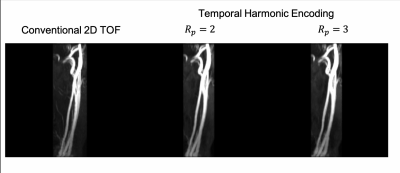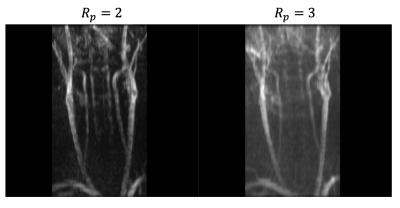Tzu-Cheng Chao1, Guruprasad Krishnamoorthy2, and James G. Pipe1
1Department of Radiology, Mayo Clinic, Rochester, MN, United States, 2Philips Healthcare, Gainesville, FL, United States
1Department of Radiology, Mayo Clinic, Rochester, MN, United States, 2Philips Healthcare, Gainesville, FL, United States
Temporal Harmonic Encoding proposed in this work could improve quality of TOF MRA by removing pulsatile flow artifacts. In addition, the harmonic components could also unveil the dynamic information for reference.

Fig 2. The maximum intensity projection of the reconstruction images are compared. Flow void can be found around bifurcation (red arrow). Inhomogeneous signal distribution can also be found in the upper stream of carotid arteries (yellow arrow). Temporal Harmonic Encoding helps reduce these artifacts and the quality becomes better as $$$ R_p $$$ increases.

Fig 3. The images are from the root-mean-square of the harmonic components in the two Temporal Harmonic Encoding experiments. The bright signals indicate region with high motion contents. Although these images also contains artifacts due to parallel imaging decomposition, the dynamic information in the image may still serve as reference.
